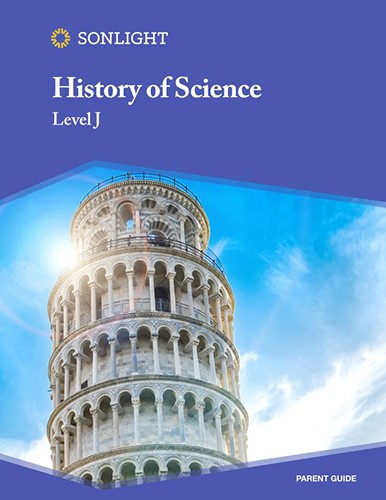Sonlight’s History of Science course (History Level J) is recommended for students in grades eight through ten. This new course (2018) provides full coverage for Bible, world history, and literature for one school year. Using real books along with the History of Science Instructor’s Guide, students learn about the development and applications of science over the past 4,000 years. Lessons follow the chronology of history from ancient civilizations around the world up to modern times. As students learn about scientific developments, they simultaneously learn some of the history and geography of the times and places where these occurred.
Bible reading is scheduled for each week, drawing chronologically from the first and second books of Chronicles, the gospel of Mark, the book of Acts, some of the epistles in the New Testament, and other books of the Bible. Memory passages are assigned for each week. This religion component of the course also has students read the books Disappointment with God, Finding Truth, and What’s So Amazing About Grace? Most books used in the entire History of Science course are secular, however, some such as these three are written to help students develop a strong Christian faith and a biblical worldview.
The lengthy book list for the course includes all three volumes of Joy Hakim’s The Story of Science series (serving as a spine for the entire course), plus other history/science titles such as The Clockwork Universe, Longitude, Stuff Matters, Archimedes and the Door of Science, and Bomb: The Race to Build. This course covers scientific discoveries and principles through history. To make a complete science course, you need to also use Sonlight's Science J course that adds hands-on experiments, lab recording, further explanation of scientific principles, and additional reading assignments from the Hakim books.
The course also leads students through a serious study of evolutionary theory and conflicting views, with books such as Evolution 2.0, Interpreting Genesis 1 with Integrity, and Censored Science. These resources should help students understand and be prepared to discuss conflicting views regarding the origins of life and the universe, even though their ultimate goal is to inculcate a Christian perspective on the topic.
For the literature component of the course, a number of books to be read aloud include some Newberry Medal and Newberry Honor titles such as Holes, A Ring of Endless Light, Penny from Heaven, and Echo, plus others such as National Geographic Book of Nature Poetry, Code Talkers, Which None Can Shut, and Shakespeare’s Secret. Some of these relate to history, while others are about family relationships and struggles, mysteries, creativity, and other topics. However, even books that relate to history are not necessarily addressing the time period students are learning about in The Story of Science series. Students will also read 16 other literary works (called readers in this course) such as The Thief, The Strange Case of Dr. Jekyll and Mr. Hyde, Treasure Island, The Giver, A Christmas Carol, The Phantom Tollbooth, and Enchantress from the Stars.
Notes and discussion questions for both the read-aloud books and the readers are in a separate section of the instructor’s guide so that parents can easily adjust the schedule as needed. These books do not need to coordinate with other course material. Since it can be difficult to stay on the exact timeline with the reading as scheduled in the lesson plans, this arrangement makes it easy for parents to use the lesson material when it is needed or skip a book entirely. As you probably have gathered, the course relies primarily upon reading and discussion.
The instructor’s guide for the course supplies parents and students with weekly lesson plans. Lesson plans include charts showing pages to be read in the required books for that week. A chart with the schedule is followed by teaching instructions and specific notes for the required readings, including discussion questions, answers, and notes about points made in the books that might be controversial, out-of-date, or incorrect. The guide also directs timeline and map activities, lists vocabulary words and their definitions, and explains other activities. For example, regarding current events reports, it says, “Three times each week, students must report verbally on some matter of significant local, regional, national, or international concern that they have read about during the previous week” ( p. 6). It explains how to do this and recommends sources that you might want to use.
The final section of the guide shows the scope and sequence for the entire course for easy reference. It also has detailed charts showing when students should add figures and dates to their timelines. It indicates which figures are included in the timeline packet for this course.
Sonlight encourages parents to adjust the course to suit their own children. You can purchase items individually, or you can buy the complete course.
Sonlight’s History of Science course is unique in its approach. Learning about science in a chronological fashion adds an entirely new dimension of understanding that many people have never been taught. Even though the course uses many secular books, the questions and comments along with coverage of evolution and the Bible component of the lessons make it most appropriate for Christian homeschoolers.










